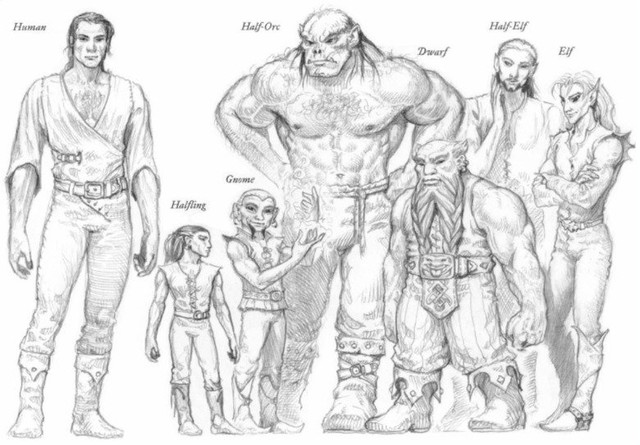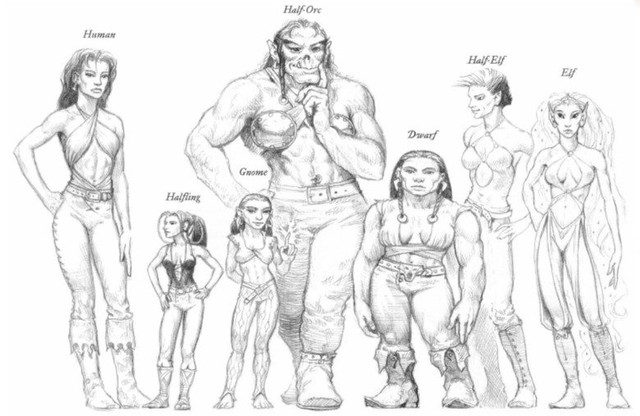

Character Races
Click on the race/subrace name for links to their individual pages.
Humans
With lifespans that flash by in the blink of an elven eye, humans must make the most of their lives in the limited number of years given to them. Their energy and passion allows them to accomplish great things, yet their relative lack of historical perspective ensures that many of their greatest accomplishments will fall to dust, worn down by the sands of time. Unlike the other humanoid races, humans are not segregated into easily identifiable subraces with distinct racial traits. However, humans do vary greatly in appearance and are divided into innumerable competing nations, states, sects, religions, bandit kingdoms, and tribes.
Major Ethnicities
Calishite, Chondathan, Damaran, Illuskan, Mulan, Rashemi, Tethyrian
Minor Ethnicities
Arkaiun, Bedine, Chultan, Durpari, Ffolk, Gur, Halruaan, Imaskari, Lantanna, Maztican, Nar, Netherese, Raumviran, Sharran, Shou, Sossrim, Talfir, Tashalan, Tuigan, Turami, Ulutiun, Vaasan
Half-Elves
Common half-elves are descended from humans and moon elves, sun elves, wild elves, or wood elves. While these people can be found all over Faerûn. Common half-elves blend human and elven features, influenced by the subrace of their elven parent and the ethnicity of their human parent. Moon half-elves have pale skin tinged bluish around the ears and chin, framing their lower faces. Sun half-elves have bronzed skin, and hair of gold. Wild half-elves have brown skin. Wood half-elves have coppery skin tinged with green highlights.
Half-Orcs
Half-orcs are fairly common throughout Faerûn. They have no true homeland to call their own and as a result most spend their lives wandering the world in search of a purpose. Half-orcs are invariably the product of a human and an orc, but stories are told of half-orcs carrying the blood of dwarves, goblins, hobgoblins, and even halflings, gnomes, and elves. Orcs are a fecund race, and such stories likely have some genesis in truth. A half-orc is usually about as tall as a human and a little heavier. Their skin tends to be gray with green or even purple undertones, and their faces feature sloping brows, jutting jaws with prominent teeth, and flat, squashed noses. This and their coarse body hair make their lineage plain for all to see.
Dwarves
As enduring as the earth from which they were shaped, the Stout Folk once ruled vast empires that sprawled on and beneath the surface of Faerûn. After centuries of decline, most dwarven kingdoms are gone, but the fruits of their labors survive, unbowed by the passage of time. In recent years, the Thunder Blessing has sparked a dwarven renaissance that might one day restore the Stout Folk to their former glory.
Shield Dwarves
Found largely in the northern reaches of western and central Faerûn, shield dwarves are the dominant northern branch of the Stout Folk. Renowned for their smithwork and craftsmanship, shield dwarves have endured a centuries-long decline in the face of never-ending wars with orcs, goblins, giants, and trolls.
Gold Dwarves
Found largely in the South in the immediate vicinity of the Great Rift, gold dwarves are the dominant southern branch of the Stout Folk. Renowned not only for their smithwork and craftsmanship but also for their military prowess and legendary wealth, gold dwarves have maintained their empire for millennia, unbowed by the passage of time.
Elves
Originally hailing from another realm far removed from Faerûn in the distant past, the elves have proved to be one of the most successful and diverse races to appear on Abeir-Toril. They have taken to the lands, the seas, and even the skies of Faerûn, colonizing and expanding through the ages. Today, the great elven realms may have retreated from the encroachment of humans and humanoids, but the elven influence in the world is unmistakable and pervasive.
NOTE: In TDN's narrative, elves cannot become Monks due to racial alignment and cultural differences inherently making such concepts extremely unlikely.
Moon Elves
The most common of the elven subraces on Faerûn are the moon elves. They have fair skin, sometimes tinged with blue, and hair of silver-white, black, or blue; humanlike colors are somewhat rare. Their eyes are blue or green, with gold flecks. Moon elves are more impulsive than the other elves, and dislike remaining in one place for any significant amount of time. Most moon elves are happiest when traveling, especially across the expanses of untrodden wilderness that still survive in Faerûn.
Sun Elves
The majority of Faerûn’s sun elves live on Evermeet, having abandoned what remained of their ancient realms during the centuries following the falls of Illefarn and Cormanthyr. They are only now returning to the mainland to reestablish their presence there. The sun elves are famed for their command of both arcane and divine magic, which exceeds that of any other living race. Works of elven high magic thousands of years old still survive in the hidden refuges of the sun elves.
Wood Elves
The wood elves are among the most numerous of Faerûn’s elven people, a young and confident folk who hold the old elven forest homelands in strength. Heirs to the second generation of elven nations, the wood elves see their realms as the natural successors to lands such as Eaerlann and Cormanthyr. Where the old empires expanded with strength and pride, the realms of the wood elves hope to grow with compassion and humility. The wood elves do not view their homelands as a land apart from Faerûn; they understand better than their kindred that for better or worse, their fates are bound up with the fates of the humans, dwarves, and halflings around them.
Wild Elves
The wild elves of Faerûn are insular and savage, and as a result are rarely seen outside their forest homes. In ages past the wild elves (or green elves, as they were more commonly known) raised great kingdoms in the forests and fielded armies to defend their homes, but with the march of time they have abandoned the trappings of civilization, becoming a furtive, reclusive race. The wild elves were always close to nature, even more so than other elves, but they have forgotten many of the high arts and lore of their people, choosing stealth and survival over building and book learning. Wild elves are stocky and strongly built for elves. Their skin tends to be dark brown, and their hair ranges from black to light brown, lightening to silvery white with age. They are quiet around anyone except their own kind, and quickly become hostile in these uncomfortable situations.
Gnomes
Industrious, intelligent, and good-natured, gnomes have few enemies. They are not a numerous race, and for many centuries, gnomes have survived and thrived by keeping a low profile. Avoiding the notice of larger folk obsessed with empires and mighty magic, the gnomes have quietly spread across Faerûn in tiny settlements and hidden villages that often go completely unnoticed by their neighbors.
Rock Gnomes
Rock gnomes are the gnomes that most people are familiar with, so much so that when someone says “a gnome,” he or she is almost always speaking of a rock gnome. Unlike their reclusive cousins, the deep gnomes and the forest gnomes, the rock gnomes are an inquisitive and loquacious people. They are renowned throughout Faerûn as technicians, alchemists, and inventors, as well as illusionists of the highest order. They do not care much for living in larger cities, where their talents are in high demand, and prefer the rolling hills of the countryside. But anywhere they find themselves, they display an amazing zest for life and all the pleasures it holds.
Halflings
Halflings fit into dwarven, gnome, elven, and human societies wherever they can, often leaving little or no impression on their neighbors. The halflings prefer it this way, so they can live their lives as they want without interference. Most nonhalflings forget about far-away Luiren and its population of militant and territorial halflings.
Strongheart Halflings
The strongheart halflings are, like the ghostwise and lightfoot hin, native to Luiren. They trace their ancestry back to the same long-lost days as the other subraces, but unlike their cousins, the stronghearts elected to remain in their homeland following the events of the Hin Ghostwar. The legacy of Chand, the strongheart war chieftain who galvanized his tribe against the threat of the feral ghostwise, lives on today in a nation that both reinforces and defies many of the expectations nonhalflings have of this race.
Lightfoot Halflings
The folk of Faerûn are more familiar with the lightfoot hin than with either of the other two subraces, primarily because the lightfoots are the most numerous and widely traveled of all the halflings. Nearly every human community of any size larger than a village has at least a few halfling residents. When most Faerûnians think of halflings, the lightfoots are the people that most often leap to mind.

